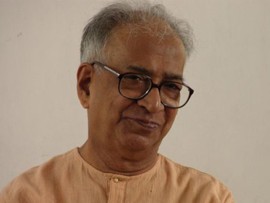Subramanyan was born in 1924 in a village in Kerala, India, and initially studied economics at Presidency College, Madras. During freedom struggle he was actively involved and was known for his Gandhian ideology. He was even imprisoned and later banned from joining government colleges during the British Rule. The turning point of his life, as an artist, came when he visited Santiniketan to study in Kala Bhavan, the art faculty of Visva Bharati University, in the year 1944. Under the tutelage such pioneers of modern Indian art as Nandalal Bose, Benode Behari Mukherjee and Ramkinkar Baij, Subramanyan studied there till 1948. In 1951 he became a lecturer at the Faculty of Fine Arts in M.S. University in Baroda. He went to study briefly in London at the Slade School of Art as a British Council scholar in 1956. While having already gone back to Baroda as a professor in painting and continuing there, he did a short stint in New York as a Rockefeller Fellow in 1966. In 1980, Subramanyan went back to Santiniketan to teach in his alma mater Kala Bhavan, Visva Bharati University, in his capacity as a professor in painting, which he continued till he retired in 1989. In the same year he was made a Professor Emeritus of Visva Bharati. K.G. Subramanyan is among the few artists who have explored the possibilities of modern art from a different perspective, giving new dimensions to the human figure by making them appear more as characters from various myths and traditional narratives, populating a composition quite the contrary. As an artist he is extraordinarily versatile, cherishing the facility to work in diverse media, sizes, and techniques over a stylistic conformity to a single medium, genre, size, technique, and manner of visualization. A prolific writer, scholar, teacher and art historian, Subramanyan uses his in-depth knowledge of various artistic traditions to create fantastical images of wit and eroticism that are universal in their appeal, yet coupled with iconic symbols drawn from Indian legends and folklore. Subramanyan has time and again aimed at blurring the boundaries between art and the artisan. The artist has also dabbled in glass painting and toy making, even weaving, which is generally considered ‘artisanal’. Even in his written works, the exploration of art as a language or means of communication is a recurring theme. Subramanyan has also illustrated as well as authored fiction for children.
